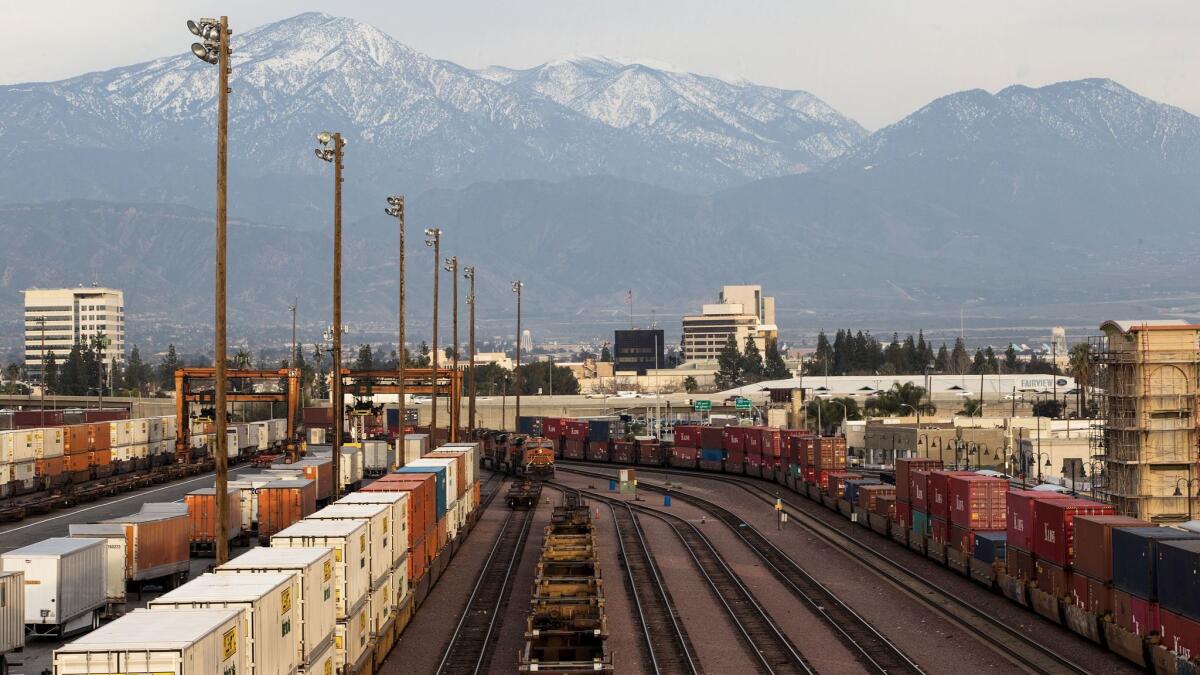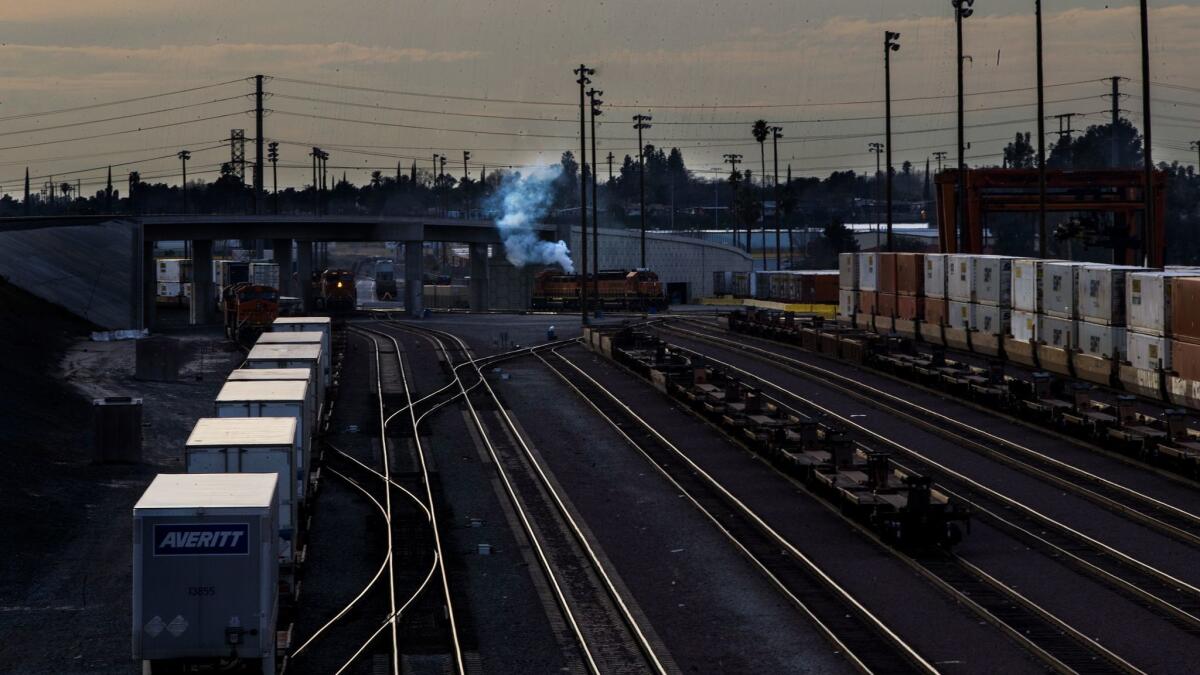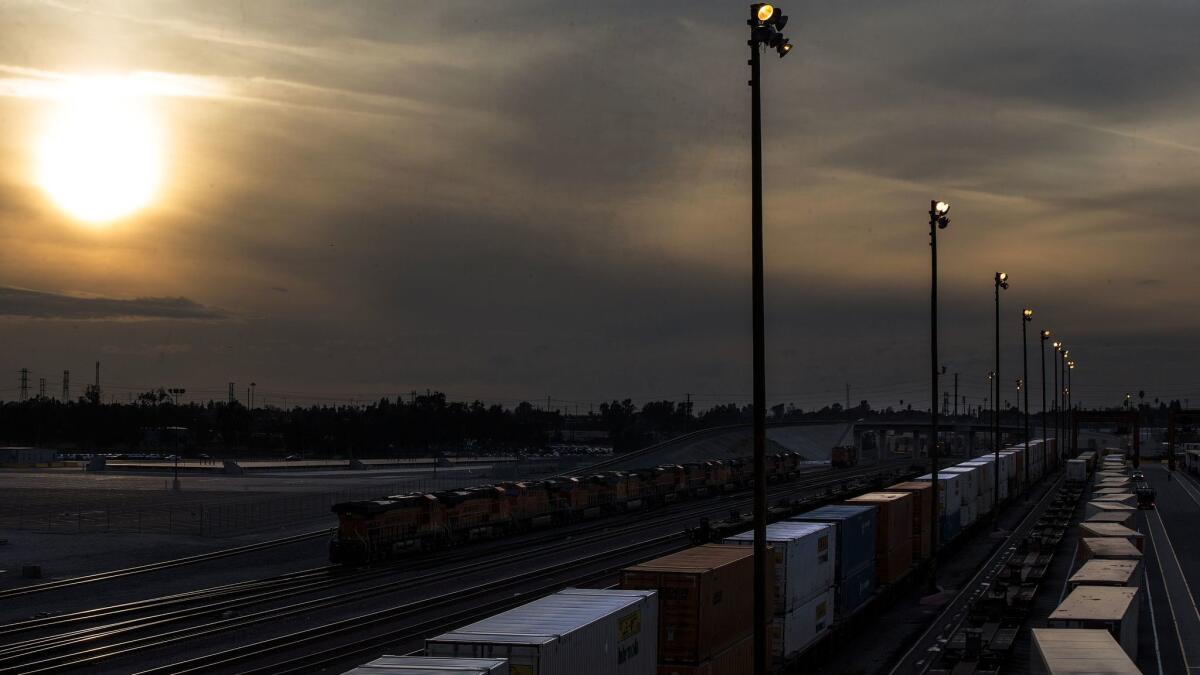Air quality board set to adopt smog plan with voluntary measures for ports, tougher rules on refineries

- Share via
Southern California air quality regulators are poised to adopt a pollution-reduction plan Friday that relies on voluntary measures from ports, warehouses and rail yards responsible for much of the region’s harmful emissions.
The South Coast Air Quality Management District board also appears likely to adopt a tougher regulatory stance toward oil refineries as part of a plan to ease the nation’s worst smog and reduce its harm to the health of Southern Californians over the next 15 years.
But the agency’s voluntary approach to lowering the pollution caused by the diesel trucks, ships and trains that haul millions of tons of goods through the region is more consequential, because the freight industry creates a far greater amount of Southern California’s smog.
The district’s intention to collaborate with freight haulers, at least initially, is backed by cargo-moving industries, which have long argued that formal regulations by the region’s smog-control agency would stifle job growth.

Environmentalists, meanwhile, have expressed outrage, saying that the district’s anticipated decision will slow progress in curbing emissions and will hurt millions of people, including many suffering from asthma, lung and heart disease and other pollution-related illnesses.
Instead of imposing emissions targets and rules on goods-movement hubs that attract large numbers of trucks, ships and locomotives, the air district plan seeks the cooperation of the industry to make its own reductions. If the facilities fail to agree to adequate and enforceable measures within a year, regulators will switch tactics and proceed with formal rules.
Philip Fine, the air district’s deputy executive officer, said that the plan’s potential for tougher regulations in the future makes the approach “more aggressive than we have been in the past on warehouses and rail yards and airports, and I would even say ports.”
“We’re not shying away from a fight with the ports,” Fine said. “What we’re saying is we think we can get more and faster emission reductions by bringing everyone to the table…. We can achieve more, at least starting out, in a collaborative approach.”
We’re not shying away from a fight with the ports.... We can achieve more, at least starting out, in a collaborative approach.
— Philip Fine, AQMD deputy executive officer
Critics of the proposal point out, however, that it comes at a time when there are questions about whether the state’s pollution-reduction measures will be subject to strict federal oversight under the Trump administration, which has pledged to roll back government regulation.
That could bring less scrutiny of Southern California’s smog-reduction measures from the U.S. Environmental Protection Agency, which has the power to reject state and local air quality plans deemed inadequate and force stronger measures in their place.
The air district’s 462-page road map for slashing emissions, set to be voted on at a public hearing Friday, is being considered as Southern California’s decades-long progress in fighting smog shows signs of faltering.
Last year was the worst summer smog season in years, with 132 bad air days — up from 112 the previous year — across the South Coast basin, which includes 17 million people throughout Los Angeles, Orange, Riverside and San Bernardino counties. Ozone reached its highest levels since 2009, and area hospitals and asthma clinics reported spikes in patients seeking medical treatment for respiratory illness.
Driving the plan are federal deadlines in 2023 and 2031 to reduce ozone pollution, the lung-damaging gas in smog that is found at the nation’s highest levels in the inland valleys and mountains of Southern California. Heavy-duty trucks are the region’s top source of nitrogen oxides, exhaust pollutants that bake in the sunlight to form ozone.
Environmentalists and community groups say the plan backslides on previous efforts by the agency to regulate ports and other freight operations.
Meeting ozone-reduction mandates under the Clean Air Act will require the agency go beyond existing regulations to slash smog-forming nitrogen oxide emissions 55% by 2031. Much of that reduction must come from trucks, trains, cargo ships and other transportation-related sources that release the bulk of the pollution into the basin, and most of the changes must happen in the first seven years.
About 40% of the nation’s imported goods pass through the ports of Los Angeles and Long Beach, supporting hundreds of thousands of jobs across Southern California.
“Our pollution exists because we are the hub for the national economy in terms of goods movement,” said San Bernardino County Supervisor Janice Rutherford, a Republican member of the AQMD board who believes that stepping in to force emissions reductions “with the huge hammer of regulations” would harm businesses across the region.
But environmentalists and community groups say the plan backslides on previous efforts by the agency to regulate ports and other freight operations.
“People are getting sick and dying now from air pollution from the freight industry and the ports, so why are we waiting to get tough on them?” said Adrian Martinez, an attorney for the environmental law nonprofit Earthjustice.

Also at issue in the plan is whether the air district will continue to regulate smog-forming emissions from oil refineries and other large stationary facilities through its troubled pollution-trading program called the Regional Clean Air Incentives Market, or RECLAIM.
The air district’s cap-and-trade program for nitrogen oxide pollution, established in 1993 to offer flexibility to regulated facilities, is favored by industry groups and business-aligned air board members. But the program has come under fire recently from state regulators, lawmakers and environmentalists for allowing refineries to avoid installing pollution controls and falling short of promised emissions reductions.
Though the clean-air plan calls for continued use of the RECLAIM program to reduce nitrogen oxide pollution, last fall the air district revised it to float the idea of phasing out the program and replacing it with traditional “command and control” regulations.
The likelihood of the program’s elimination has increased since Republicans lost their 7-6 majority on the air board two months ago. Board members are expected Friday to propose sunsetting the program, a measure that appears likely to win the support of the board’s six Democrats and one unaffiliated member.
Los Angeles City Councilman Joe Buscaino, a Democrat whose district in the harbor area includes the port complex and oil refineries and is seen as a key vote, concluded it is time to end the program, which “has served its purpose in capping the amount of pollution,” said Jacob Haik, his deputy chief of staff.
An air district analysis conducted as part of the plan found that the health benefits of meeting federal pollution-reduction deadlines would far outweigh the billions in costs to industry, the government and consumers.
Not that improved health comes cheap. The district’s proposal for how to clean the air has also sparked debate for its $14-billion price tag, the amount the agency estimates must be spent to deploy enough low-emitting vehicles and equipment to meet smog-reduction deadlines. The plan calls for finding new sources of money to increase local, state and federal spending on clean-air incentive programs tenfold, to $1 billion a year.
Southern California’s air quality has improved dramatically over decades as a result of years of tightening emissions regulations, but it still does not meet federal health standards going back to 1979. Polluted air in the region is linked to thousands of premature deaths, emergency room visits and missed school days a year.
Continued reductions from the Los Angeles-Long Beach port complex are crucial to easing those health problems because the complex is the single largest air pollution source in the basin, according to the air district.
In California, pollution from vehicles and other mobile sources are generally regulated by state and federal authorities, while local air district controls stationary sources like refineries and factories. The South Coast district has long asserted it also has the authority to impose “indirect source rules” to control emissions from ports, rail yards and other facilities at which large numbers of trucks, trains and ships pick up and drop off goods.
Two previous air district plans in 2007 and 2012 contained such rules for the ports.
The latest plan omits them, projects a 14% increase in nitrogen oxide emissions from the ports of Los Angeles and Long Beach by 2022, and sets no targets or rules to bring those levels down.
The ports have reduced emissions dramatically through their clean trucks program and other steps taken starting in 2006 and have achieved the goals of their joint Clean Air Action Plan. But they have long fought efforts by the air district to regulate their operations or hold them accountable for their emissions-reduction pledges.
An updated clean-air plan proposed recently by the ports, though still under development, contains no additional commitments to reducing nitrogen oxide pollution. In a joint letter, the ports argued that the potential for future regulations by the air district “brings significant uncertainty that will have broad negative effects on the goods movement industry and the economy as a whole.”
Rick Cameron, who manages environmental affairs at the Port of Long Beach, said that under the voluntary plan the port would seek to sign a memorandum of understanding with the air district detailing emissions-cutting steps it will take.
“We’ve been adamant for many years now that a rule coming from AQMD is not necessary because of our success,” said Cameron.
Fine, the air district’s deputy executive officer, said that one reason the agency did not propose adopting emissions-cutting regulations immediately is fear that the ports and other operations could sue to try to block their implementation.
It is a “non-negotiable” part of the plan that the ports and other freight-handling operations develop voluntary measures specific and meaningful enough that they would be approved by the U.S. Environmental Protection Agency to become federally enforceable under the Clean Air Act, Fine said.
The plan is going to a vote about a year after Republicans seeking more industry-friendly regulation gained a majority of seats on the 13-member air board and fired the group’s longtime executive, who had pushed for more stringent rules on the goods-movement industry. Republicans lost their majority two months ago, but there is a lot of pressure from business groups to adopt the industry-friendly policies.
“Business leaders across the multi-county region don’t like many aspects of the plan, but it’s time to put it to bed and move on to the implementation work,” said Tracy Hernandez, chief executive of the Los Angeles County Business Federation. She urged the air board to adopt the plan without changes despite its “tremendous costs on industry.”
More to Read
Sign up for Essential California
The most important California stories and recommendations in your inbox every morning.
You may occasionally receive promotional content from the Los Angeles Times.











